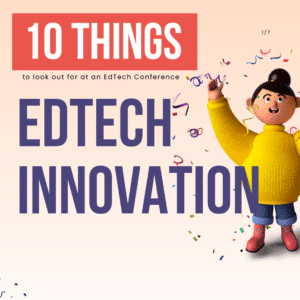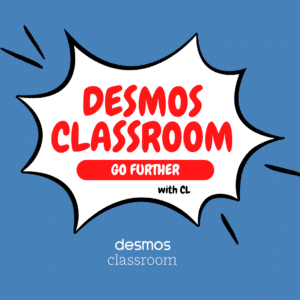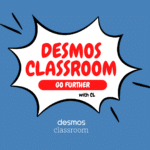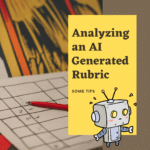As educators, we face an exciting era of innovation and transformation, where technology is reshaping the landscape of education. One of the avenues to understand, embrace, and incorporate these advancements into our pedagogy is by attending EdTech conferences. However, to truly harness the power of EdTech and avoid tools that lack substance, there are certain aspects we must bear in mind. Here are ten things to look out for when visiting an EdTech conference.
1. Pedagogy First Approach
The most effective EdTech tools are those that seamlessly support sound pedagogical methods. Before being dazzled by the technology, it’s important to evaluate how the tool supports teaching and learning. Does it fit into your curriculum? Does it foster engagement and enhance the learning experience? If it doesn’t support pedagogy, it is a solution looking for a problem.
2. Support for the 4 C’s
Good EdTech tools support the 4 C’s: Communication, Collaboration, Critical Thinking, and Creativity. These skills are vital for students in the 21st century, and the right technology should provide opportunities for students to develop and refine them.
3. Student-Centered Tools
Beware of tools that reinforce traditional, teacher-centered methods. The best EdTech tools are student-centered, promoting active learning, fostering independence, and personalizing the learning experience.
4. Empowerment and Opportunity
Great EdTech tools empower students, providing them with opportunities to learn and grow in ways that were previously impossible. They should offer platforms for students to explore, experiment, and express their understanding in unique and diverse ways.
5. Beyond “Worksheets Faster”
A tool that only digitizes traditional tasks or speeds up mundane activities, like filling out worksheets, isn’t truly leveraging the power of EdTech. Seek out tools that do more than automate – those that innovate, inspiring new ways of teaching and learning.
6. Paradigm Shifts
We’ve been educating in much the same way for centuries. Now, technology gives us the chance to rethink this paradigm. Be on the lookout for tools that offer a significant shift in how we approach education, moving us away from the one-size-fits-all model and towards personalized, learner-centered, and engaging education.
7. Differentiated Pacing
Not all students learn at the same pace or in the same way. EdTech can and should address this. Look for tools that allow for differentiated learning, offering students the opportunity to learn at their own pace, in a manner that suits their individual interests.
8. Fueling Creativity
Creative thinking is crucial in today’s fast-paced, ever-changing world. The right EdTech tools, such as Book Creator, should provide opportunities for students to create rather than simply consume, driving them to think outside the box and innovate.
9. Enhancing Critical Thinking
EdTech should do more than present information; it should provide opportunities for students to analyze, synthesize, and evaluate that information. Look for tools that stimulate critical thinking and problem-solving skills.
10. Rethinking Assignments
With AI and other advancements, we can reassess how we assign and assess student work. EdTech offers innovative ways to assess student learning beyond traditional tests and quizzes. These tools can provide insights into a student’s learning journey, capturing progress over time and offering formative assessments that can inform instruction and support student growth.
Get Past EdTech Glitter
Not all that glitters in the realm of EdTech is gold. While flashy tools might be exciting, we need to discern the real game-changers from the superficial. As we delve into the world of EdTech conferences, let’s champion pedagogy first, seek out tools that genuinely empower our students, enhance the 4 C’s, and provide groundbreaking opportunities to rethink our educational practices. The potential of EdTech is boundless, but it is in our hands to utilize it effectively, responsibly, and with discerning wisdom.
- I Dare You to Care About This Math Problem
- EdTech Tools
- Google Classroom: EdTech Challenge
- What Makes EdTech Engaging?
- Shake Up Learning Book – Snag A Copy
-
10 Ways Teachers Can Unleash the Power of Appsheet
AppSheet lets teachers build their own apps without code! Here are 10 ways to use AppSheet for teachers for custom classroom solutions.
-
CTRL L: Leveling Up Student-Centered Learning with a Simple Shortcut
The simple shortcut Ctrl+L might seem insignificant, but it can be a powerful tool in a student-centered classroom.
-
Chrome for the Classroom: Essential Updates Every Teacher Should Know
Chrome is always improving. If you use Chrome for the classroom you will want to check out these essential updates.
-
30 Keyboard Shortcuts That Teachers Need
The secret to feeling more confident on the computer is keyboard shortcuts! Here are 30 Keyboard Shortcuts That Teachers Need
-
Hide All Tabs – Google Sheets
Have a lot of tabs in your Google Sheets spreadsheet? Here is how to hide all tabs at once, quickly.
-
Transform Your Lessons: The Power of Desmos Classroom Computation Layer
Take Desmos Classroom even further with the computation layer. Customize your lesson with the CL.















